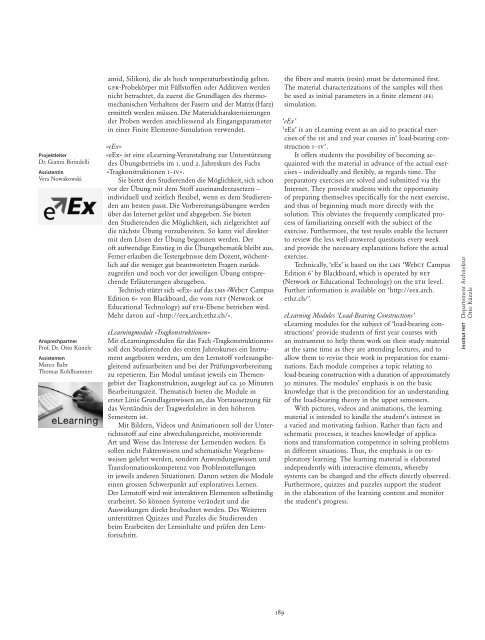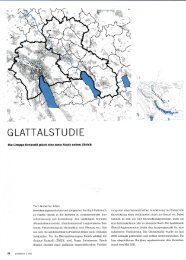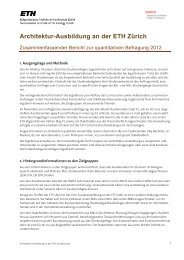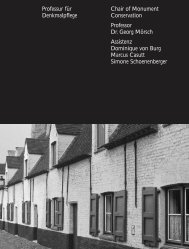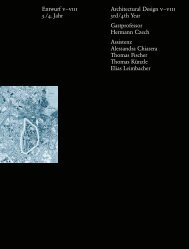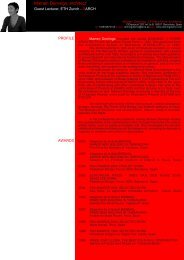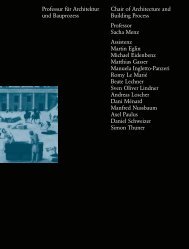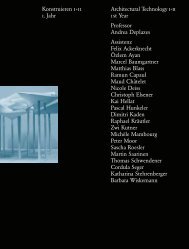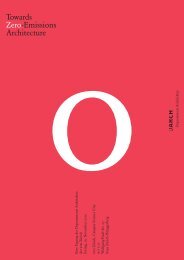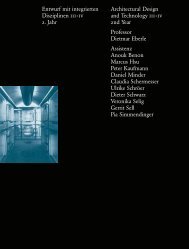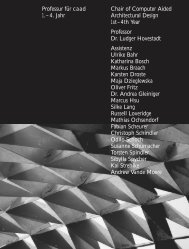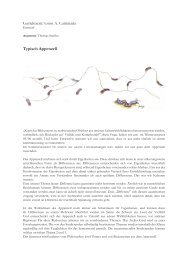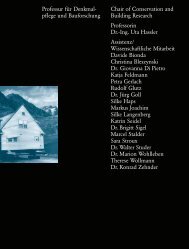Jahrbuch PDF (63MB) - ETH Zurich - ETH Zürich
Jahrbuch PDF (63MB) - ETH Zurich - ETH Zürich
Jahrbuch PDF (63MB) - ETH Zurich - ETH Zürich
Erfolgreiche ePaper selbst erstellen
Machen Sie aus Ihren PDF Publikationen ein blätterbares Flipbook mit unserer einzigartigen Google optimierten e-Paper Software.
Projektleiter<br />
Dr. Gianni Birindelli<br />
Assistentin<br />
Vera Nowakowski<br />
Ansprechpartner<br />
Prof. Dr. Otto Künzle<br />
Assistenten<br />
Marco Bahr<br />
Thomas Kohlhammer<br />
amid, Silikon), die als hoch temperaturbeständig gelten.<br />
gfk-Probekörper mit Füllstoffen oder Additiven werden<br />
nicht betrachtet, da zuerst die Grundlagen des thermomechanischen<br />
Verhaltens der Fasern und der Matrix (Harz)<br />
ermittelt werden müssen. Die Materialcharakterisierungen<br />
der Proben werden anschliessend als Eingangsparameter<br />
in einer Finite Elemente-Simulation verwendet.<br />
«eEx»<br />
«eEx» ist eine eLearning-Veranstaltung zur Unterstützung<br />
des Übungsbetriebs im 1. und 2. Jahreskurs des Fachs<br />
«Tragkonstruktionen i–iv».<br />
Sie bietet den Studierenden die Möglichkeit, sich schon<br />
vor der Übung mit dem Stoff auseinanderzusetzen –<br />
individuell und zeitlich flexibel, wenn es dem Studierenden<br />
am besten passt. Die Vorbereitungsübungen werden<br />
über das Internet gelöst und abgegeben. Sie bieten<br />
den Studierenden die Möglichkeit, sich zielgerichtet auf<br />
die nächste Übung vorzubereiten. So kann viel direkter<br />
mit dem Lösen der Übung begonnen werden. Der<br />
oft aufwendige Einstieg in die Übungsthematik bleibt aus.<br />
Ferner erlauben die Testergebnisse dem Dozent, wöchentlich<br />
auf die weniger gut beantworteten Fragen zurückzugreifen<br />
und noch vor der jeweiligen Übung entsprechende<br />
Erläuterungen abzugeben.<br />
Technisch stützt sich «eEx» auf das lms «Webct Campus<br />
Edition 6» von Blackboard, die vom net (Network or<br />
Educational Technology) auf eth-Ebene betrieben wird.<br />
Mehr davon auf «http://eex.arch.ethz.ch/».<br />
eLearningmodule «Tragkonstruktionen»<br />
Mit eLearningmodulen für das Fach «Tragkonstruktionen»<br />
soll den Studierenden des ersten Jahreskurses ein Instrument<br />
angeboten werden, um den Lernstoff vorlesungsbegleitend<br />
aufzuarbeiten und bei der Prüfungsvorbereitung<br />
zu repetieren. Ein Modul umfasst jeweils ein Themengebiet<br />
der Tragkonstruktion, ausgelegt auf ca. 30 Minuten<br />
Bearbeitungszeit. Thematisch bieten die Module in<br />
erster Linie Grundlagenwissen an, das Vorraussetzung für<br />
das Verständnis der Tragwerkslehre in den höheren<br />
Semestern ist.<br />
Mit Bildern, Videos und Animationen soll der Unterrichtsstoff<br />
auf eine abwechslungsreiche, motivierende<br />
Art und Weise das Interesse der Lernenden wecken. Es<br />
sollen nicht Faktenwissen und schematische Vorgehensweisen<br />
gelehrt werden, sondern Anwendungswissen und<br />
Transformationskompetenz von Problemstellungen<br />
in jeweils anderen Situationen. Darum setzen die Module<br />
einen grossen Schwerpunkt auf exploratives Lernen.<br />
Der Lernstoff wird mit interaktiven Elementen selbständig<br />
erarbeitet. So können Systeme verändert und die<br />
Auswirkungen direkt beobachtet werden. Des Weiteren<br />
unterstützen Quizzes und Puzzles die Studierenden<br />
beim Erarbeiten der Lerninhalte und prüfen den Lernfortschritt.<br />
189<br />
the fibers and matrix (resin) must be determined first.<br />
The material characterizations of the samples will then<br />
be used as initial parameters in a finite element (fe)<br />
simulation.<br />
‘eEx’<br />
‘eEx’ is an eLearning event as an aid to practical exercises<br />
of the 1st and 2nd year courses in‘ load-bearing construction<br />
i–iv’.<br />
It offers students the possibility of becoming acquainted<br />
with the material in advance of the actual exercises<br />
– individually and flexibly, as regards time. The<br />
preparatory exercises are solved and submitted via the<br />
Internet. They provide students with the opportunity<br />
of preparing themselves specifically for the next exercise,<br />
and thus of beginning much more directly with the<br />
solution. This obviates the frequently complicated process<br />
of familiarizing oneself with the subject of the<br />
exercise. Furthermore, the test results enable the lecturer<br />
to review the less well-answered questions every week<br />
and provide the necessary explanations before the actual<br />
exercise.<br />
Technically, ‘eEx’ is based on the lms ‘Webct Campus<br />
Edition 6’ by Blackboard, which is operated by net<br />
(Network or Educational Technology) on the eth level.<br />
Further information is available on ‘http://eex.arch.<br />
ethz.ch/’.<br />
eLearning Modules ‘Load-Bearing Constructions’<br />
eLearning modules for the subject of ‘load-bearing constructions’<br />
provide students of first year courses with<br />
an instrument to help them work on their study material<br />
at the same time as they are attending lectures, and to<br />
allow them to revise their work in preparation for examinations.<br />
Each module comprises a topic relating to<br />
load-bearing construction with a duration of approximately<br />
30 minutes. The modules’ emphasis is on the basic<br />
knowledge that is the precondition for an understanding<br />
of the load-bearing theory in the upper semesters.<br />
With pictures, videos and animations, the learning<br />
material is intended to kindle the student’s interest in<br />
a varied and motivating fashion. Rather than facts and<br />
schematic processes, it teaches knowledge of applications<br />
and transformation competence in solving problems<br />
in different situations. Thus, the emphasis is on exploratory<br />
learning. The learning material is elaborated<br />
independently with interactive elements, whereby<br />
systems can be changed and the effects directly observed.<br />
Furthermore, quizzes and puzzles support the student<br />
in the elaboration of the learning content and monitor<br />
the student’s progress.<br />
Institut HBT Departement Architektur<br />
Otto Künzle


